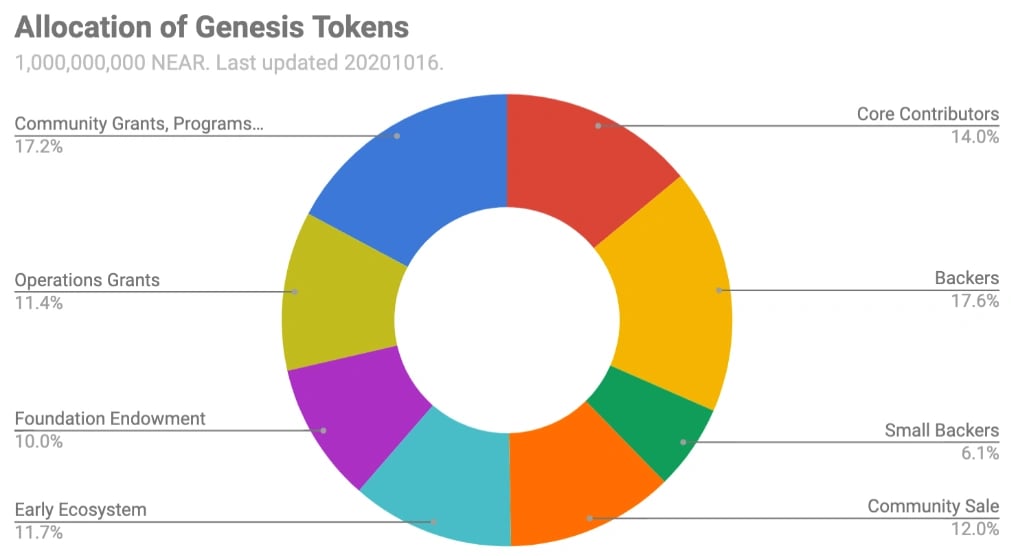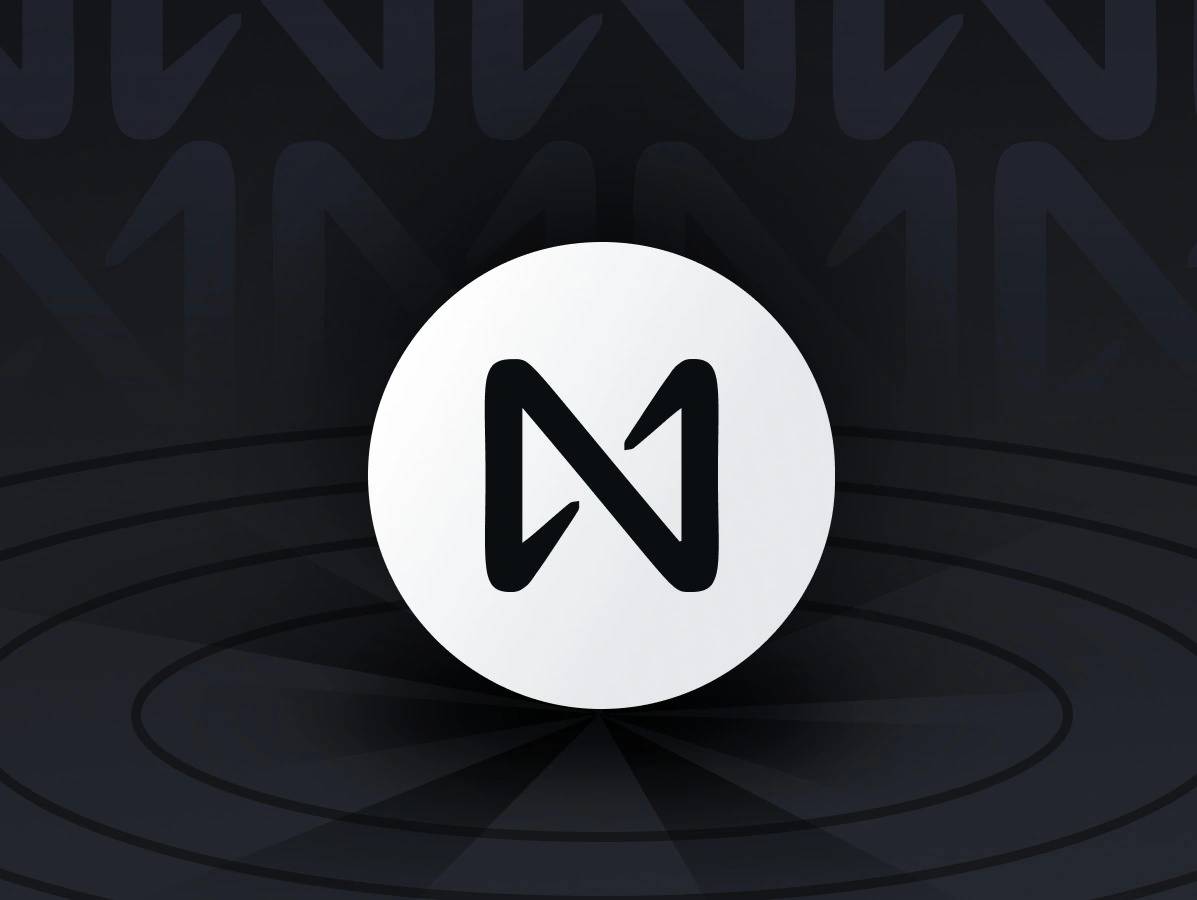위키 구독하기
Share wiki
Bookmark
NEAR (token)
NEAR (token)
NEAR 토큰은 Proof-of-Stake 기반의 Layer 1 공개 블록체인인 Near Protocol의 네이티브 암호화폐입니다. 분산형 애플리케이션(탈중앙화 애플리케이션)을 구축할 수 있습니다. 이 토큰은 거래 수수료 지불 및 스토리지에 사용되며, 보유자는 스테이킹하여 거래 검증 및 네트워크 합의에 참여할 수 있습니다. [1][2][3]
토큰 경제학
2020년 4월 22일 제네시스 시점에 1,000,000,000 NEAR 토큰이 생성되었습니다. 배분은 다음과 같습니다. [2] [4]
- 커뮤니티 지원금 및 프로그램: 17.20%
- 핵심 기여자: 14.00%
- 커뮤니티 판매: 12.00%
- 초기 생태계: 11.76%
- 운영 지원금: 11.40%
- 재단 기금: 10.00%
- 후원자: 17.6%
- 소규모 후원자: 6.1%

에포크 보상으로 네트워크 지원을 위해 매년 추가 공급량의 5%가 발행되며, 이 중 90%는 검증자에게(총 4.5%), 10%는 프로토콜 재무부에(총 0.5%) 지급됩니다. 거래 수수료의 30%는 거래와 상호 작용하는 계약에 대한 환급으로 지급되고, 나머지 70%는 소각됩니다. [1]
검증자
보상
검증자는 연간 총 공급량의 약 5% 중 고정된 90%를 지급받습니다(나머지 10%는 프로토콜 재무부로 지급됨). 보상은 에포크마다(반나절마다) 배포됩니다. 각 검증자는 참여 비율에 비례하여 보상을 받습니다. 검증자는 스테이킹을 통해 간단한 경매를 통해 자리를 확보합니다. 각 에포크가 끝나면 검증자는 예상 생산량 대비 실제 생산한 블록과 청크 수를 기준으로 평가됩니다. [7]
예상치의 90% 미만이면 검증자는 오프라인/불안정으로 간주되어 보상을 받지 못하며 다음 에포크의 검증에서 제외됩니다(즉, 강제 언스테이킹). 온라인 참여율이 90% 이상인 검증자는 보상이 선형적으로 증가하며, 온라인 참여율이 99% 이상인 경우 보상의 100%를 받습니다. [7]
위임
검증자는 위임을 통해 제3자로부터 $NEAR를 스테이킹할 수 있습니다. NEAR Protocol은 스마트 계약을 통해 위임을 가능하게 합니다. 위임을 수락하려는 검증자는 특수 계약을 생성하고 자신의 노드를 운영하고 싶지 않은 사용자가 $NEAR를 예치할 수 있도록 허용할 수 있습니다. 그렇게 하면 해당 계약에 예치된 자금은 생성자가 자신의 스테이크의 일부로 사용할 수 있습니다. [7]
유틸리티
네트워크 보안
NEAR Protocol은 지분 증명(PoS) 네트워크이므로 다양한 공격에 대한 저항력은 NEAR 스테이킹에서 비롯됩니다. 스테이킹된 NEAR는 네트워크를 유지하고 NEAR의 애플리케이션 및 사용자를 위한 거래를 처리하는 분산형 서버 인프라를 나타냅니다. 이 서비스 제공에 대한 보상은 NEAR로 받습니다. [8]
계정 단위 제공
NEAR는 NEAR 인프라에서 가격 계산 및 스토리지에 사용됩니다. 네트워크는 변경 사항 및 거래를 처리하기 위해 NEAR로 거래 수수료를 부과합니다. [8]
교환 매체
NEAR는 NEAR 애플리케이션과 계정 간에 가치를 전송하는 데 사용할 수 있습니다. 애플리케이션은 데이터 액세스 또는 기타 복잡한 거래와 같은 다양한 기능에 대해 NEAR를 사용하여 요금을 부과할 수 있습니다. 또한 기관은 신뢰할 수 있는 제3자가 거래를 청산하고 결제할 필요 없이 서로 간에 NEAR를 쉽게 교환할 수 있습니다. [6][8]
Bitwise, NEAR 기반 ETF 제안
2025년 5월, Bitwise Asset Management는 미국 증권거래위원회(SEC)에 Bitwise NEAR 디지털 자산 신탁 출시 승인을 요청하는 규제 신청서를 제출했습니다. 제안된 펀드는 현물 상장지수펀드(ETF) 구조를 통해 NEAR Protocol 블록체인의 네이티브 자산인 NEAR 토큰에 대한 직접적인 노출을 제공하도록 설계되었습니다.
이 신청서는 NEAR 토큰과 관련된 거래 활동 증가 및 가격 상승과 함께 제출되었습니다. 신청서에 따르면, 이 신탁은 기관 투자자가 자산의 직접 보관 또는 취급에 참여하지 않고도 NEAR에 접근할 수 있도록 합니다.
Bitwise의 제안서는 NEAR의 생태계 내 현재 사용에 기여하는 여러 네트워크 기능을 설명합니다. 여기에는 거래 수수료 매체, 프로토콜 거버넌스 도구 및 탈중앙화 애플리케이션 배포 구성 요소로서의 기능이 포함됩니다. 또한 이 신청서는 WebAssembly 기반 스마트 계약, 체인 추상화 메커니즘 및 계정 집계를 프로토콜의 운영 아키텍처의 일부로 언급합니다.
제출 당시 SEC는 공식적인 답변이나 검토 일정을 발표하지 않았습니다. 이 제안서는 비트코인과 이더리움과 같은 기존 토큰을 넘어 디지털 자산과 연결된 규제 투자 수단에 대한 지속적인 관심을 반영합니다. [9] [10] [11]
잘못된 내용이 있나요?
